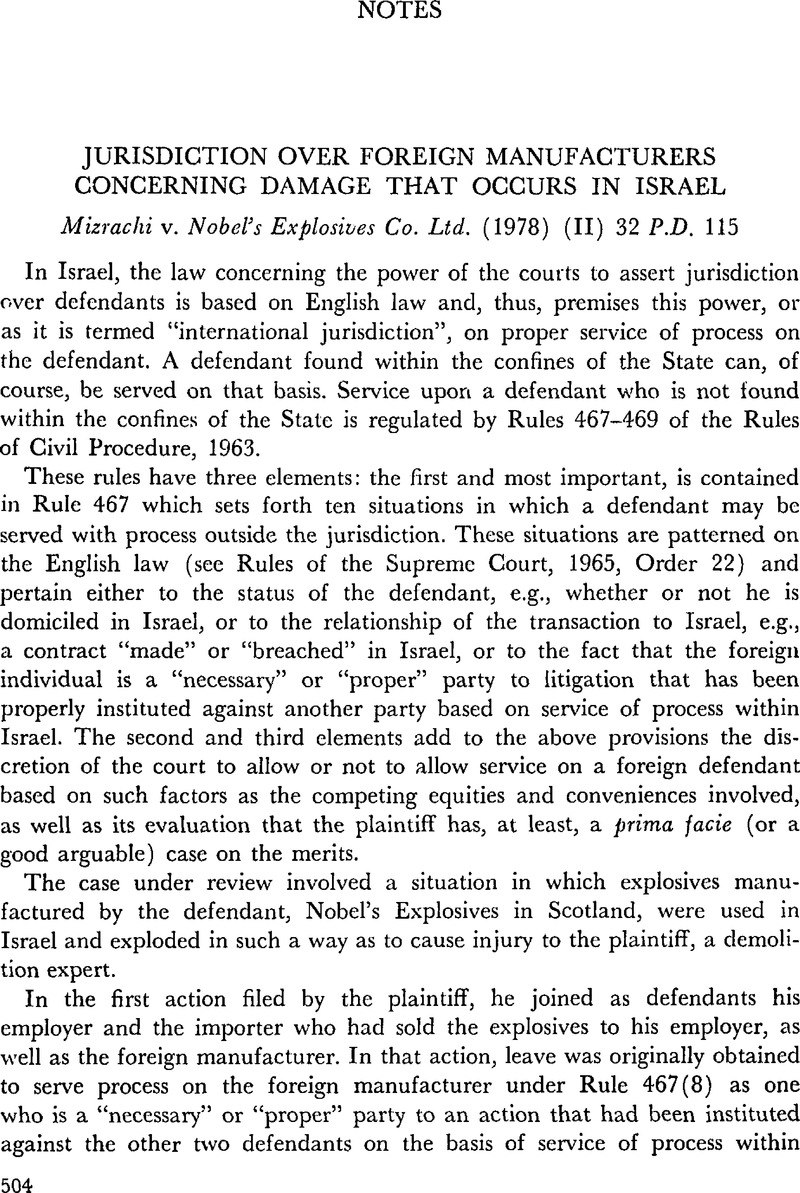No CrossRef data available.
Article contents
Jurisdiction over Foreign Manufacturers Concerning Damage that Occurs in Israel
Published online by Cambridge University Press: 12 February 2016
Abstract

- Type
- Notes
- Information
- Copyright
- Copyright © Cambridge University Press and The Faculty of Law, The Hebrew University of Jerusalem 1979
References
1 See George Monroe Ltd. v. American Cyanamid Corp. (1974) 170 L.T. 281; Cordova Land Co. Ltd. v. Victor Brothers Inc. (1966) 1 W.L.R. 793.
2 See New York Civil Practice Law and Rules, Section 302(a)(3) which provides for jurisdiction over a defendant “who in person or through an agent”:
3. commits a tortious act without the state causing injury to person or property within the state, except as to a cause of action for defamation of character arising from the act, if he
(i) regularly does or solicits business, or engages in any other persistent course of conduct, or derives substantial revenue from goods used or consumed or services rendered in the state, or
(ii) expects or should reasonably expect the act to have consequences in the state and derives substantial revenue from interstate or international commerce”; and see also the Uniform Interstate and International Procedure Act (1962) Section 1.03 which provides for “jurisdiction over a person who acts directly or by an agent, as to a cause of action arising from the person's…
4. causing tortious injury in this state by an act or omission outside this state if he regularly does or solicits business, or engages in any other persistent course of conduct, or derives substantial revenue from goods used or consumed or services rendered, in this state …”
3 See Koronel v. Koronel (1975) (I) 29 P.D. 259; Liebher v. The Gazit and Shacham Construction Co. Ltd. (1967) (II) 21 P.D. 243.
4 See Feathers v. McLucas, 15 N.Y. 2d 443, 261 N.Y.S. 2d 8, 209 N.E. 2d 68 (1945). Following this decision of the New York Court of Appeals that construed the then applicable New York Rule that provided for jurisdiction over a defendant who “commits a tortious act within the State” not to apply to a case of negligent act without the State that causes damage within the State, the New York Rule was amended to provide a limited jurisdiction in such cases. See supra n. 2.
5 Compare nn. 4 and 6 as to the possible interpretations of this language.
6 See Gray v. American Radiator and Standard Sanitary Corp., 22 III. 2d 432, 176 N.E. 2d 761 (1961) in which the Illinois Supreme Court held that the Illinois Statute providing for jurisdiction on the basis of “the commission of a tortious act within this State” did apply to a case of a negligent act without the State that caused damage within the State. In Feathers v. McLucas, supra n. 4 the New York Court of Appeals expressly refused to follow this Illinois authority. It should be noted, however, that the word “tortious” in the Illinois statute, does not appear in the Israeli Rule. In its decision the Illinois Supreme Court emphasized that word and noted that a negligent act does not become tortious under the substantive law of torts unless and until damage occurs.
7 See supra nn. 2, 4 and 6.
8 Supra n. 3.
9 Rule 20 of the Israeli Rules of Civil Procedure, 1963 provides: “All persons may be joined in one action as defendants against whom any right to relief is sought—whether jointly, severally, or in the alternative—in respect of or arising out of the same act or transaction or the same series of acts or transactions, or as a result of any of these, and where, if separate actions had been brought against them, any common question of law or fact would arise…”
10 See Rules 7(5), 78 and 105(a)(1).
11 See also supra n. 6.
12 (1977) (II) 31 P.D. 466.
13 The English rule is clear that “every sale or delivery of a written or printed copy of a libel is a fresh publication”, Lambert v. Roberts [1933] 2 W.L.R. 508, and hence a fresh, complete and new tort. And this, indeed, is the traditional common law rule in the matter. See also Gatley, on Libel and Slander (7th ed., Sweet and Maxwell, 1974)Google Scholar paras. 236, 237 and 833. On the other hand, the majority of jurisdictions in the United States have apparently now adopted a “single publication” rule under which an entire edition of a newspaper, magazine or book is treated as only one publication which is treated as complete when the finished product is released by the publisher for sale in accord with trade practice. See Presser, W.L., Law of Torts (4th ed., West Pub. Co., 1971) sec. 764.Google Scholar
14 (1973) (I) 27 P.D. 361.
15 Compare Koronel v. Koronel, supra n. 3, with Josephon v. Josephon (1976) (I) 31 P.D. 729.
16 See also Distillers Co. (Biochemicals) Ltd. v. Thompson [1971] A.C. 458; Diamond v. Bank of London and Montreal (CA.) [1979] 2 W.L.R. 228.




